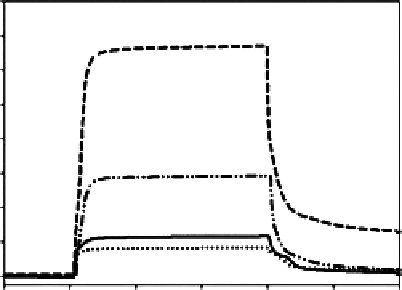Biomedical Engineering Reference
In-Depth Information
conjugate via cleavage of the succinate linker under physiological conditions [214]. However,
there is slight activity loss by two- or threefold observed with the conjugated form.
It is well known that chitosan is mucoadhesive. To examine the mucoadhesive proper-
ties of LMWC and LMWC-DTX, SPR analysis was carried out using small intestinal BBM
vesicle-coated SPR chip.
Figure 3.25
shows the binding response of each LMWC and the
conjugate onto the BBM vesicle-coated chip surfaces. LMWC-DTX groups (1 and 2 mM
LMWC equivalent) exhibited rapidly increasing response signals of ~3.4- and ~5.6-fold
compared to LMWC groups (1 and 2 mM) and slow dissociation from BBM vesicles-coated
surfaces. This result suggests clearly that LMWC-DTX retains the mucoadhesiveness of
parent LMWC. It is speculated that the larger mucoadhesiveness of the conjugate may be
attributed to the increased hydrophobicity, resulting in enhanced interactions with the
intestinal epithelial layers.
Pharmacokinetic parameters after oral administration of LMWC-DTX were derived
and compared with those of DTX administered intravenously (formulated in Tween 80/
ethanol/saline: an identical formulation to commercial Taxotere). DTX was detectable in
plasma up to 72 h for LMWC-DTX (p.o.), whereas DTX was undetectable beyond 6 h for
DTX (i.v.), suggesting that DTX is released from LMWC-DTX conjugate in a sustained
manner over a long period of time. The relevant pharmacokinetic parameters, including
C
max
,
T
max
,
t
1/2
, and
AUC
0−∞
, are listed in
Table 3.5.
Whereas DTX (i.v.) showed a very short
plasma half-life of
t
1/2
=0.6 h with a rapid decrease in plasma concentration, LMWC-DTX
groups (5 and 10 mg DTX 276 equivalent/kg, p.o.) exhibited significantly delayed
t
1/2
values of 3.4 and 8.2 h. In addition,
C
max
of the conjugate (p.o.) was larger than that of
DTX (i.v.) (2.1 ± 0.27 versus 0.82 ± 0.1).
The oral bioavailability obtained from LMWC-DTX is the highest among others reported
in the literature to date. This unprecedented high absorption may be attributed to the
known ability of LMWC to be mucoadhesive and to open a tight junction of intestinal epi-
thelial layers. Furthermore, LMWC-DTX conjugates may also be able to bypass both the
P-gp efflux system (displayed on intestinal epithelial cells) and cytochrome P450-mediated
drug metabolism (hepatic clearance), as demonstrated in the report on oral delivery of
160
2 mM LMWC-DTX
140
120
100
80
1 mM LMWC-DTX
60
40
2 mM LMWC
20
1 mM LMWC
0
0
100
200
300
Time (s)
400
500
600
Figure 3.25
SPR response curve for binding of LMWC and LMWC-DTX to ileal BBM surfaces. Ileal BBM vesicles were
coated onto an L1 sensor chip, after which LMWC and LMWC-DTX (each 1 and 2 mM) were injected at a flow
rate of 2 L/min.

Search WWH ::

Custom Search